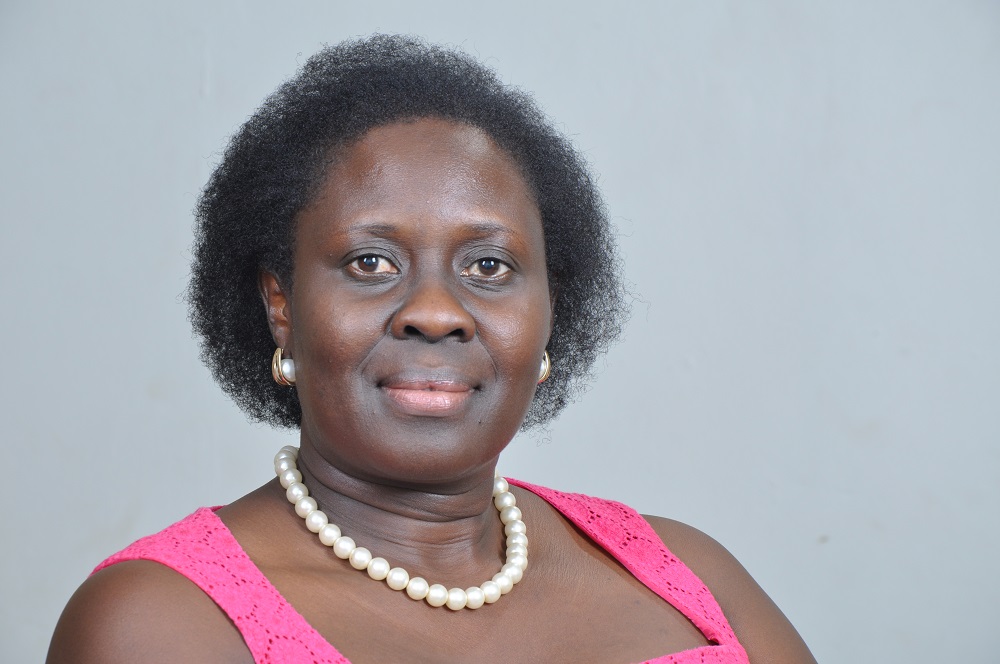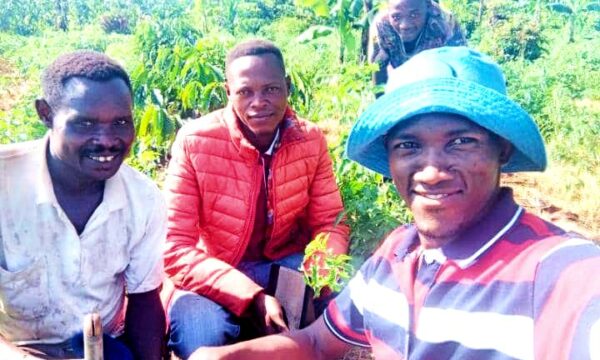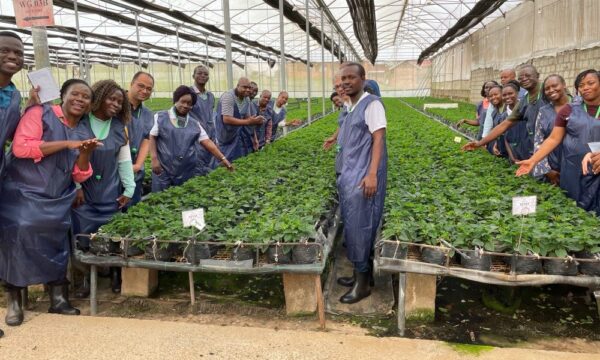
As part of UN International Day of Women and Girls in Science, we turn the focus on CABI’s own female scientists to highlight the invaluable work they contribute towards our mission of helping smallholder farmers grow more and lose less to crop pests and diseases. Here we find out more about Christine Alokit who takes lead on the production and implementation of communication materials for various stakeholders and extension – coordinating CABI’s activities to help smallholder farmers in Uganda increase their yields and livelihoods.
Christine has worked on a range of projects aimed at using multiple communication methods to increase agricultural productivity including ‘promoting good seed in East Africa,’ ‘Africa soil health’ as part of the Africa Soil Health Consortium, ‘Optimizing Fertilizer Recommendations in Africa’ under OFRA, ‘managing maize lethal necrosis disease in eastern and central Africa.’
What motivated you to work in science and development?
During my undergraduate degree in BSc in Agriculture from Makerere University, I majored in Agricultural Extension. One of the course units I learnt was Agricultural journalism that encompassed writing articles for farmers, extension, photography among other aspects. At that time, I did not immediately realise how much I would apply that knowledge. When I got a job later as an extension worker, I realised the continuous need for information among farmers and other agricultural actors. Working with an NGO then, Winrock International provided the opportunity for continuous interaction with agricultural research scientists – I always obtained some leaflets that I shared with farmers and extension. I, however, did not think much on the presentation of these materials and how the target audience perceived them.
Video: ‘Banana and I’ episode 1 from the series of videos that Christine worked on – helping farmers learn better ways of managing banana production through drama.
As I advanced in my career, I have always been faced with questions on where to get information for various agricultural problems by farmers, processers, traders, friends and relatives. This made me realise how much information actually exists that does not get to intended beneficiaries. Sometimes if disseminated, it is not well packaged and target audiences misses out. I have been to situations where a farmer asks me to tell the researchers to get a solution for their rotting cassava in the garden or ask how they can control striga weed in their maize gardens. Imagine being asked such and yet I know solutions exist! So that made me realize that as much as there is vast information, people who need that actually do not access it.
Video: ‘Mr Nutribean’ – another video Christine worked on to help educate children on the benefits of eating iron and zinc-rich beans.
With that interest, while managing Farm Africa’s dairy goat project in Eastern Uganda, the project carried out various trainings but with no aspect of communication. I got staff to develop communication materials for extension and lead farmers including engaging media houses to make documentary and wrote a television script and appeared to radio and television shows. The project did not have a communication staff but I championed the communication activities that turned out to be successful.
Joining Kilimo Trust later, I got involved in editorial work and also worked with media house to produce striga documentary. I wrote a script without ever having had training on how to do it and the video came out well. These communication outcomes made me happy and appreciate the need to properly package and disseminate agricultural information.
When I saw a CABI advert for an Agricultural Communication Scientist, I knew it was the sort of thing I wanted to do. I have realised my passion in communication and the ability to actually connect with people who have the information given my agricultural background.
Which female scientist inspires you and why?

There are several female scientists documented in history that made good strides in inspiring me in my science career. However, I will mention two current scientists Engineer Winnie Byanyima, Executive Director UNAIDS and Professor Ruth Oniang’o, a nutritionist, former politician and a member of CABI governing board. These have gone beyond the technical science and demonstrated that it is possible to make practical change in peoples’ lives at the various positions they held – management and politics. Sometimes we need to get on to various disciplines with our science background to actually apply it in changing peoples’ daily lives. The fact that as a scientist, one can also rise to high level decision-making levels is admirable. I have stepped out of the mainstream science to manage CABI programs and do communication work to reach out to various stakeholders in agricultural sector. I pride in that!
What has been your biggest achievement?
Having a feeling of self-worth through my communication career has been very rewarding. I have worked with scientists and made them appreciate value of communicating their work. Through practical hands on training scientists and extension workers realised they can package information into simple messages that can easily be understood and applied by farmers. Through various engagements, the scientists and extension workers developed various materials; story charts for low literate farmers, they developed radio campaign messages, drama and animation scripts, editing videos among some of the products and participated in organising and conducting mass extension campaigns.
I receive feedback from time to time that gives me encouragement and self-worth in contributing to better farming. One NARO scientist had this to say ‘in the past we put communication activities in our project proposals and ended up only taking photographs as communication activities done. I did not know that communication was so broad’ In another incidence during a 12-week radio campaign on banana improvement; a district leader was reported to have highly appreciated the value of communication saying ‘we used to plan to give out only inputs to farmers but he came to realize that information was of much value than just giving farmers inputs.’
Having participated and led development of materials and dissemination campaigns enabled me gain lots of learning from communication colleagues and partners that enabled me do so much I had not imagined. These strongly make me realize my contribution.
What barriers have you faced as a woman in your work and how have you overcome them?
I have sometimes experienced some level of resistance by some scientists to appreciate the role of communicating their research outcomes beyond scientific journal publications. My role is to help convince them that there is wider benefit of disseminating their research to different audiences – including stakeholders such as other project partners, donors, farmers and the media.
I have overcome some of these barriers through identifying scientists interested in communicating the research outcomes and worked with them to reach out. Given that in most cases the materials have been uploaded to the CABI website, this has enabled me share with extension workers from time to time. And with my role managing various CABI projects I am able to reach out to several extension workers. I continuously get requests for information and, therefore, able to share as much as possible.
What does the future hold for you and other women working in science and development?
There is significant contributions women can make in science and the development sector. The agricultural sector is wide with several commodities and actors in various commodity valued chains. Women need to critically focus their interest areas and should embrace communicating their work vigorously. The social media can support them reach out to a big audience and women should embrace use of the internet as well.
In doing this, however, we should constantly take recognition and consideration of that one woman in some village who has no access to even a feature mobile phone but struggles daily to provide for the family. How does what you do change the lives of such women? What simple technologies are available or can be innovated to support such women to enable them get out of poverty? Such women make a big contribution in feeding and raising nations and may never get any recognition anywhere for their tireless effort to provide for families. How do such women benefit from our work?

I have personally enjoyed working with various stakeholders to package information and disseminated to various stakeholders. There is considerable need for information, there is vast information out there and yet more effort is required to repackage what exists and continuously disseminate.
The science and development arena are so wide and interconnected to other fields. There is so much we can contribute and this requires thinking of our work beyond the current disciplines and working with multidisciplinary teams.
What advice would you give to girls and women thinking of pursuing a career in agricultural extension and communication?
Agricultural extension and communication is a very exciting and challenging area given the vast actors involved in various commodity value chains. These all require regular up to date information on various technologies and management practices.
There is so much need for our effort to contribute to this world in all disciplines and communication cuts across. I encourage science women to step out and actually reach out to intended people with information. You might have fantastic outcomes from your research but that will add lot of value if it is packaged for lower level audiences that have to use it. What research are you doing? What is relevant to be communicated to the public at every point in time? Take keen interest in communication and don’t leave it to journalists only. Actually, having a good understanding of communication helps one work with journalists better. There are short free online communication courses that one can do to improve their communication skills.
I happen to be part of a team of my high school old girls’ association that conducts mentoring sessions for young girls annually except 2020 which was affected by COVID pandemic. I encourage young girls interested in taking science to do so. Believe in what you are doing and put in effort. Finding mentors can be a challenge but science women should step out to reach out to mentor young girls. They need to demystify the science to them so they can make good choices of their interest.
Additional information
Christine recommends that women scientists take advantage of the free Script ‘Media Skills for Scientists Course’ which can help them communicate their science to the online, print and broadcast media.
Find out more about Christine’s work in the following projects:
‘Managing maize lethal necrosis disease in eastern and central Africa’
Related News & Blogs
CABI’s GRASP Fellowship awardee working in partnership to help increase food safety in Uganda’s urban markets
Dr Monica Kansiime, who was awarded a Gender Responsive Agriculture Systems Policy (GRASP) Fellowship aimed at improving policy process in agri-food systems, is working in partnership to help increase food safety in Uganda’s urban fresh fruits and vege…
30 January 2024




